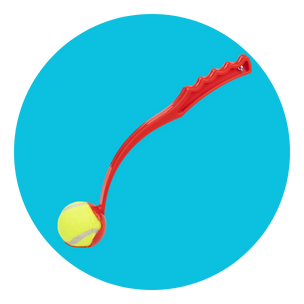Dog Toys
Dog toys that keep your pup entertained & happy
Dog Toys & Chews
Dogs thrive when they have plenty of toys to play with, not only for fun, but for mental stimulation, exercise, and even dental health. Dog toys provide much-needed enrichment, helping to challenge your dog’s mind and keep boredom at. Regular play with toys gives your pup physical exercise and can strengthen the bond you share, whether it’s a game of fetch in the park or a tug-of-war in the living room. Chew toys in particular can also support dental hygiene by cleaning teeth and massaging gums as dogs, making playtime healthy as well as enjoyable.
Frequently Asked Questions
What are the best toys for aggressive chewers?
For dogs that are heavy chewers, the best toys are those made from ultra-durable materials like hard rubber or nylon. Look for toys labeled “tough” or “indestructible,” such as KONG Extreme rubber toys, which are built to withstand strong jaws. Avoid plush or thin rubber toys that can be shredded easily. No toy is completely indestructible, so always supervise play and replace toys once they show significant wear or damage.
Which toys are safe for puppies?
The safest toys for puppies are ones that are size-appropriate, soft enough for their baby teeth, and free of small parts that could be swallowed. Choose durable rubber or nylon toys specifically made for puppies, these help with teething but won’t break apart easily. Soft plush toys can be great comfort items, but supervise your pup to ensure they don’t pull off any stuffing or squeakers. Always check that a toy isn’t too small for your puppy’s mouth (to prevent choking) and that it’s made from non-toxic materials.
How do I choose an interactive toy for my dog?
When selecting an interactive toy or puzzle for your dog, consider your dog’s skill level and what motivates them. If your dog is food-motivated, a treat-dispensing puzzle toy can keep them engaged as they figure out how to release the treats. For problem-solvers, try puzzles with hidden compartments or sliders. Start with a simpler puzzle and gauge your dog’s interest, you can then move up to more challenging toys that really exercise their brain.
Interactive toys are fantastic for combating boredom and can make your dog more relaxed and content through mental stimulation. Always supervise the first few play sessions with a new puzzle to ensure your dog doesn’t get frustrated or try to chew pieces that aren’t meant to be chewed.
Interactive toys are fantastic for combating boredom and can make your dog more relaxed and content through mental stimulation. Always supervise the first few play sessions with a new puzzle to ensure your dog doesn’t get frustrated or try to chew pieces that aren’t meant to be chewed.
What is the best way to clean dog toys?
Cleaning your dog’s toys regularly is important to keep them safe and hygienic. Most hard rubber or plastic toys can be hand-washed with warm soapy water (use a mild, pet-safe detergent) or even put in the dishwasher if the manufacturer says it’s dishwasher-safe. For plush toys, you can often put them in a gentle cycle in the washing machine (use fragrance-free, pet-safe detergent) and let them air dry.
A handy natural cleaning solution is a 50/50 mix of white vinegar and water, which can safely disinfect toys without harsh chemicals. Always avoid strong chemicals like bleach or anything toxic, since residues could harm your dog . After washing, rinse toys thoroughly and check for any damage (discard toys that are coming apart).
A handy natural cleaning solution is a 50/50 mix of white vinegar and water, which can safely disinfect toys without harsh chemicals. Always avoid strong chemicals like bleach or anything toxic, since residues could harm your dog . After washing, rinse toys thoroughly and check for any damage (discard toys that are coming apart).
What are good boredom-buster toys for dogs?
Puzzle toys and treat-dispensing toys are among the best boredom busters, as they actively engage a dog’s mind. Squeaky toys or toys with interesting textures can also capture a dog’s attention for a while. Another tip is to rotate your dog’s toys regularly, instead of giving access to all toys at once, offer a few at a time and swap them out every few days. This makes old toys seem new and exciting again. Remember that sufficient exercise is key too: a dog who has had a good walk or play session outside will be more likely to happily settle down with a chew toy or puzzle indoors instead of getting bored.
Do dog toys help with dental health?
es, certain dog toys can help keep your dog’s teeth and gums healthier. Dental chew toys or dental sticks are designed with ridges or nubs that scrape off plaque and tartar as the dog chews. Rope toys can also act like floss by sliding between teeth (just supervise to ensure your dog isn’t ingesting the rope fibers). Regular chewing on safe, firm toys increases saliva production, which can reduce bacteria in the mouth and promote gum health. While toys are not a replacement for brushing your dog’s teeth or professional cleanings, they are a helpful supplement to your dog’s oral care. Always choose toys appropriate for your dog’s size and chewing strength to avoid tooth damage.








